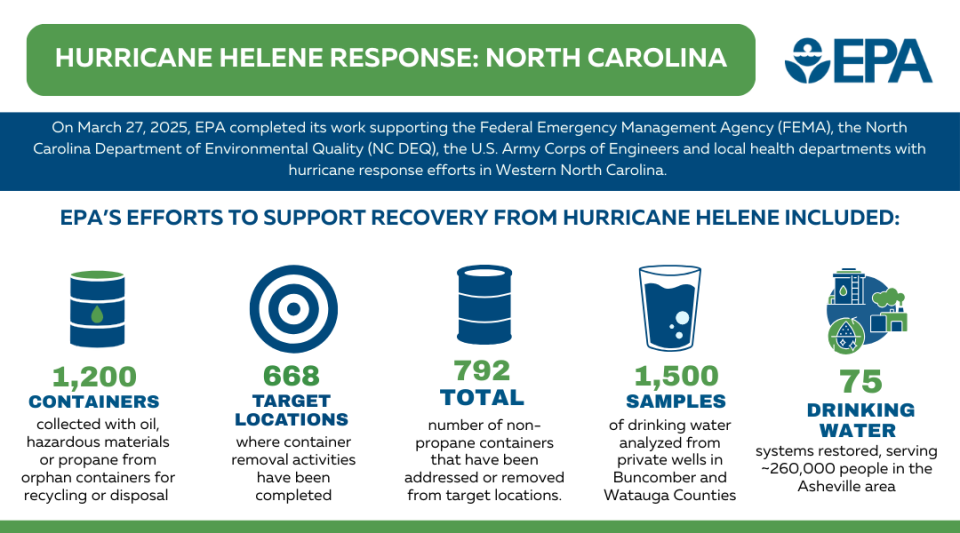EPA's Hurricane Helene Response Activities: North Carolina
On March 27, 2025, EPA completed its work supporting the Federal Emergency Management Agency (FEMA), the North Carolina Department of Environmental Quality (NC DEQ), the U.S. Army Corps of Engineers and local health departments with hurricane response efforts in Western North Carolina. EPA’s efforts to support recovery from Hurricane Helene included:
- Mobile water labs analyzing more than 1,500 drinking water samples from private wells in Buncombe and Watauga Counties.
- Working closely with state partners and local utilities to bring drinking water and wastewater systems back online. This restored service to more than 75 drinking water systems that serve approximately 260,000 people in the Asheville area.
- Collecting more than 1,200 containers with oil, hazardous materials or propane from orphan containers for recycling or disposal in response to Hurricane Helene-related damage in Western North Carolina.
- Managing approximately 20,000 gallons of oil and oil-contaminated fluids recovered from various containers, tanks, etc. This includes hazardous substances testing and transportation of the usable material to an oil recycler in Charlotte.
- Offering technical guidance to local water operators, supporting efforts to restore and maintain drinking water systems and other essential services safely.
- Advised residents about waterborne illnesses, emphasizing the importance of following local boil water advisories and staying informed through local health updates from the CDC and local health authority guidance.

Monitoring Water Quality
EPA teams actively worked with local agencies to monitor water quality in affected areas. Mobile water labs analyzed more than 1,500 drinking water samples from private wells in Buncombe and Watauga Counties. The testing was for the presence of harmful bacteria, and to provide timely information on drinking water safety. EPA, state partners and local utilities worked closely to bring drinking water and wastewater systems back online. This restored service to more than 75 drinking water systems that serve approximately 260,000 people in the Asheville area.
Waste Management and Hazardous Waste Support
FEMA issued a mission assignment to EPA to collect oil and hazardous materials from orphan containers for recycling or disposal in response to Hurricane Helene-related damage in Western North Carolina. EPA’s emergency response staff formed Hazardous Materials Assessment and Mitigation Teams to expedite orphan container recovery, hazmat assessment and response in coordination with the NC DEQ. EPA collected more than 1,200 containers with oil, hazardous materials or propane since clean-up efforts began in North Carolina.
EPA used a variety of sources to identify locations where possible orphan containers or releases to the environment were situated. This included FEMA’s search and rescue database (SARCOPS), NC DEQ’s database, United States National Oceanic and Atmospheric Administration (NOAA) aerial photography, local fire departments and emergency management agencies, National Response Center reports and any visual identification by EPA and the NC DEQ assessment teams.
EPA maintained a dashboard to track the status of target locations which required assessment. A target location could contain one or more orphan containers or none. Assessment Teams confirmed whether they had oil or other hazardous substances in a container and/or whether there were confirmed spills or releases of these materials to the environment. A recovery team was deployed to pick up the containers and/or perform any mitigation work. Hazardous substances collected were transported to a central staging area for testing and consolidation for disposal. This process was consistent except for a few materials that could be reused/recycled. This is described in more detail below. The waste at the staging area was characterized and disposed of at an appropriate disposal facility.
The materials collected were consolidated and tested for hazardous substances. If possible, some collected materials were recycled or reused. EPA managed approximately 20,000 gallons of oil and oil-contaminated fluids recovered from various containers, tanks, etc.; had it tested for hazardous substances and then arranged for the transportation of the usable material to an oil recycler in Charlotte as an example. The Agency coordinated the pickup of intact propane tanks by propane distributors so that they may potentially be placed back in service. EPA pumped oil out of numerous displaced residential fuel oil tanks and left them in place so that residents could put them back in use after inspection to prevent a release to the environment.
Technical Assistance for Infrastructure Recovery
EPA personnel offered technical guidance to local water operators, supporting efforts to restore and maintain drinking water systems and other essential services safely.
Public Health Protection Measures
EPA advised residents on precautions to prevent waterborne illnesses, emphasizing the importance of following local boil water advisories and staying informed through local health updates in collaboration with CDC guidance and local health authorities.
EPA's Hurricane Helene Response Activities
Fact Sheets and Resources
- Buncombe County Mobile Lab Flyer (pdf) (5.39 MB)
- Watauga County Mobile Lab Flyer (pdf) (5.41 MB)
- Heating System Advisory (pdf) (267.61 KB)
